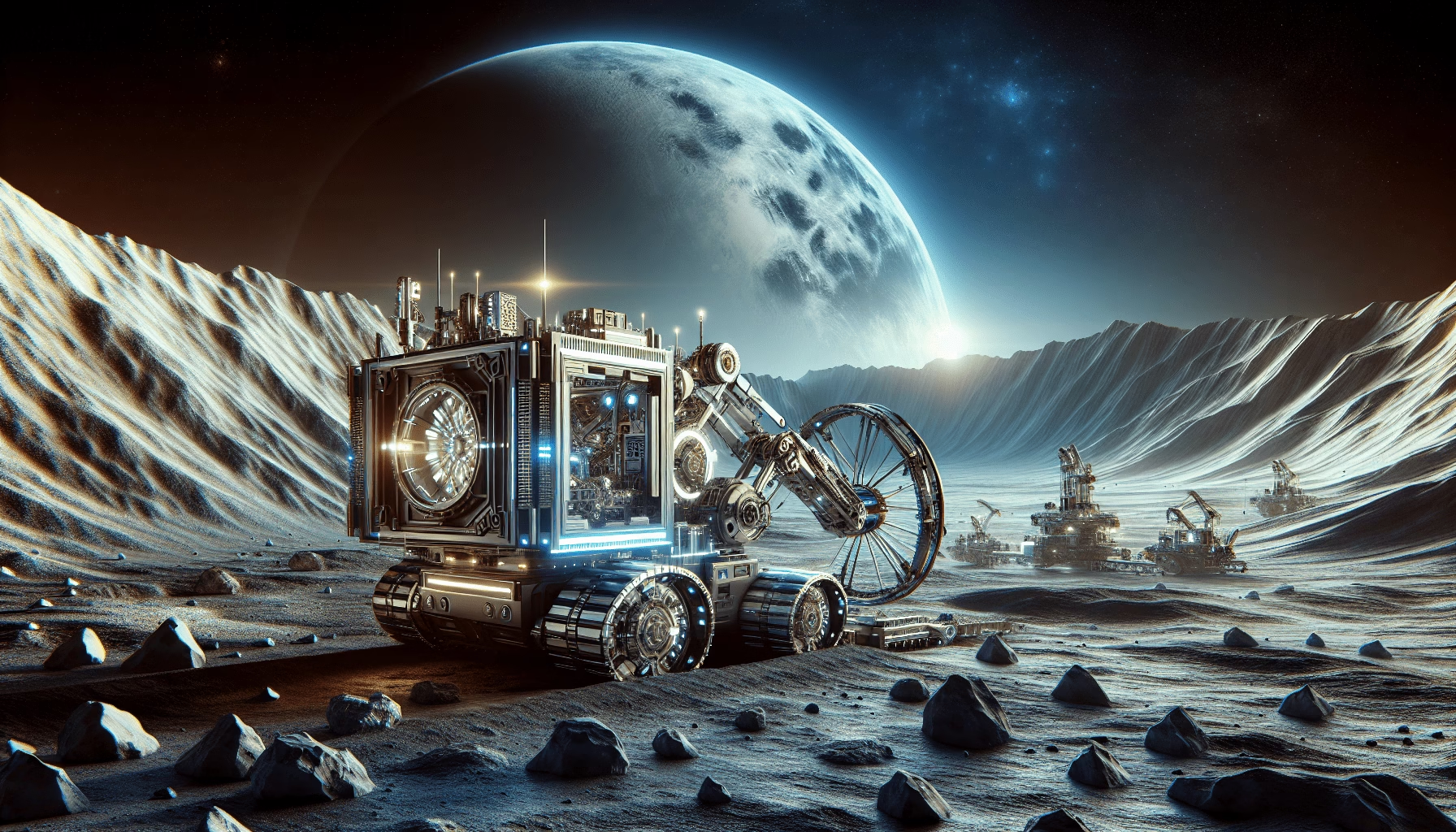Have you ever pondered the enigmatic possibilities that lie on the lunar surface, especially regarding the potential resources that could shape our sustainability endeavors here on Earth? The moon, often admired for its mesmerizing luminescence, holds more than just an aesthetic appeal. It conceals an extraordinary resource that promises to change the world’s energy landscape: Helium-3.
Lunar mining, once the stuff of science fiction, is rapidly emerging as a topic of serious consideration among scientists and policymakers. At the heart of this burgeoning interest is Helium-3 (He-3), a rare isotope on Earth yet abundantly available on the moon. This article ventures into how lunar mining, specifically for Helium-3, could potentially revolutionize Earth’s energy future.

Table of Contents
Historical and Background Context
The Emergence of Lunar Mining
The concept of lunar mining isn’t a recent development. It traces back to the mid-20th century when the space race instigated a profound interest in celestial bodies. Initially, lunar exploration was primarily driven by the desire for scientific knowledge and geopolitical supremacy. However, as humanity’s energy needs grew, attention shifted towards the moon’s untapped resources.
Fast forward to the present, and lunar mining is becoming a pragmatic ambition. It holds the promise of sustainable energy solutions, primarily through the extraction of Helium-3. Understanding this narrative gives context to the dramatic change in how we perceive the moon—not just as a celestial body but as a potential powerhouse for Earth.
Understanding Helium-3
Helium-3 is an isotope of helium, possessing two protons and one neutron. It is relatively rare on Earth, largely because it does not originate here but rather from solar winds that have permeated the lunar regolith over billions of years. With the ability to produce enormous amounts of energy through fusion without emitting harmful waste, it presents itself as a cleaner and safer energy alternative.
Despite its rarity on Earth, conservative estimates suggest that vast deposits of Helium-3 exist on the lunar surface. It’s believed that just a few shipments of Helium-3 could power entire nations for extended periods. This potential makes lunar excavation an irresistible proposition for those seeking sustainable energy solutions.
The Science and Technology of Helium-3
Fusion Power and Helium-3
Fusion power is often heralded as the ultimate energy solution—clean, sustainable, and incredibly efficient. Unlike nuclear fission, which splits atoms and produces long-lived radioactive waste, fusion fuses lighter elements to form heavier ones. The challenge, however, has been achieving a reliable and controlled fusion situation.
Helium-3 offers a unique solution because it can produce fusion without releasing neutrons, thereby minimizing radioactive waste. When combined with deuterium, another isotope of hydrogen, the fusion process yields a significant amount of energy with no long-lived radioactive byproducts. This contrast to traditional nuclear energy is what makes Helium-3 so appealing.
Mining Technologies and Challenges
While the benefits of extracting Helium-3 are immense, the technological challenges are equally daunting. The moon’s harsh environment—ultraviolet radiation, extreme temperature fluctuations, and regolith dust—poses significant hurdles.
Current technological advancements are focusing on robotic excavators, solar-powered mining equipment, and advanced materials capable of withstanding lunar conditions. Scientists and engineers are developing systems that can identify, extract, and transport lunar resources efficiently. However, the high costs and complexities of developing such technology remain formidable obstacles.

Key Concepts in Lunar Mining
Economic Viability
The economic aspects of lunar mining can’t be overlooked. The feasibility of mining Helium-3 hinges on developing cost-effective technology and transportation methods. Although initial investments are steep, proponents argue that the long-term returns will outweigh the costs, given the immense energy potential of Helium-3.
Here is a comparative table outlining the cost versus potential gain:
| Criteria | Investment Required | Potential Gain |
|---|---|---|
| Initial Infrastructure | High | Long term sustainable energy |
| Technological Development | High | Technological advancements with broad applications |
| Energy Output | Medium | Significant with Helium-3 |
| Long-Term Profits | High | High due to energy demand |
Policy and Legal Challenges
The legalities surrounding lunar mining are another critical consideration. Current international laws, such as the Outer Space Treaty of 1967, are ambiguous about the ownership and commercialization of lunar resources. Developing clear legal frameworks will be essential for any mining initiative.
Nations and private enterprises are currently at an impasse, trying to balance exploration rights with international cooperation. As lunar mining gains traction, resolving these legal challenges will be imperative to establish equitable and peaceful usage of lunar resources.
Visualizing the Process: The Steps of Lunar Mining
Understanding the lunar mining process is key to grasping its complexity and potential. The operation can be broken down into the following steps:
- Site Selection: Identifying areas rich in Helium-3 deposits using satellite imagery and robotic scouts.
- Extraction: Utilizing machinery capable of mining and processing lunar soil, or regolith, to release Helium-3.
- Processing and Storage: Transporting the extracted material to processing facilities where Helium-3 can be isolated and stored.
- Transportation to Earth: Developing cost-efficient transportation methods to bring Helium-3 back to Earth for energy production.
Implementing each of these steps involves overcoming significant technological and logistical hurdles, yet collectively, they provide a roadmap to the future of energy resources.

Case Studies and Practical Applications
Exploration and Prototype Initiatives
Several space agencies and private companies are already venturing into research and prototype development for lunar mining. NASA, for instance, has detailed plans for long-term lunar missions. The Artemis program aims to establish a sustainable human presence on the moon by the end of the decade, setting the foundation for mining activities.
Private entities such as SpaceX and Blue Origin are significantly contributing to this exploration. They are developing rocket technologies that could make space travel—and by extension, lunar mining—more accessible, comparable to how aviation went from pioneering experiments to commercial industry within decades.
Comparison of Methodologies
To understand the various approaches being explored, consider this comparison table of methodologies in lunar mining:
| Method | Advantages | Disadvantages |
|---|---|---|
| Robotic Excavation | Reduces human risk, continuous operation | High initial technology cost |
| Human-Crewed Missions | Flexibility, problem-solving on-site | High risk and operational cost |
| Hybrid Approach | Combines best of both methods | Complex logistics and coordination |
Each method has its proponents, with varying strategies on scaling up operations and minimizing costs.
Problem-Solving Strategies in Lunar Mining
Addressing Technological Challenges
Cutting-edge advancements are being prioritized. For instance, nanomaterials and robotics are key areas of focus. Durable materials that can handle lunar dust and extreme conditions are under development, along with efficient robotics that could perform tasks autonomously and with precision.
Legal and Ethical Considerations
Deliberations continue on managing the ethical and legal facets of lunar mining. Some propose creating an international lunar governing body that regulates resource distribution, ensures that benefits extend globally, and maintains peaceful and fair use of lunar resources.

Environmental Impact and Sustainability
The focus on sustainability extends to lunar operations themselves. Mining operations intend to limit environmental impact on the lunar surface using techniques that preserve the natural state. On Earth, the vast energy potential of Helium-3 could significantly cut down reliance on fossil fuels, decreasing global carbon footprints and enhancing sustainability.
Future Trends and Adaptations
High-Tech Innovations
As lunar mining concepts evolve, auxiliary technologies promise to revolutionize the field. AI-driven analytics for resource detection, blockchain for transparent resource management, and advanced AI for operational efficiency illustrate the integration of cutting-edge tech into space endeavors.
Collaboration and Development
Unprecedented partnerships between countries, private enterprises, and research institutions are fostering innovation. These collaborations will likely accelerate the pace of discovering viable solutions to the myriad challenges inherent in lunar mining operations and energy resource allocation.

Conclusion and Reader Engagement
To summarize, lunar mining and the extraction of Helium-3 envisage a new dawn in energy consumption, one that aligns with a cleaner, sustainable future. While technological challenges persist, the potential rewards fuel further exploration and innovation.
We invite your thoughts and insights into this exciting frontier. What challenges do you foresee in the race to mine Helium-3? Share your opinions, and explore related articles for more advanced insights into energy sustainability and space technology.
Additional Resources and Internal Links
For readers interested in delving deeper into the technical aspects of space exploration and energy sustainability, the following articles offer further information:
- A Beginner’s Guide to Sustainable Energy Practices
- The Role of AI in Space Exploration and Innovation
These readings will empower you with additional insights into related technological, environmental, and ethical facets surrounding lunar mining and its potential impact on Earth’s energy paradigm.

